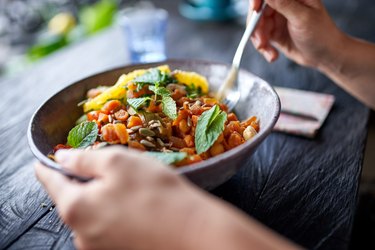
Fiber — a type of carbohydrate — is the unsung hero of the nutrition world: It helps you lose weight, keeps your digestive system regular and is even linked to preventing serious conditions such as heart disease.
It's one of those nutrients that's so essential to our everyday function, and yet, most of us aren't meeting our daily requirements, per 2017 research in the American Journal of Lifestyle Medicine.
Video of the Day
Video of the Day
The Institute of Medicine recommends men get 38 grams of fiber and women get 25 grams per day from two types of fiber — soluble and insoluble fiber — both of which come with their own health perks.
What Is Soluble Fiber?
Soluble fiber is most often touted as an all-star in regulating blood sugar levels for people with diabetes, due to the way the body processes it, registered dietitian and nutritionist, Jim White, RDN, ACSM, says.
Soluble fiber slows down our digestion and the way we absorb foods by linking with water molecules. This creates a gel-like substance that helps reduce blood glucose spikes, thus stabilizing our energy and mood, according to the Mayo Clinic. In other words: You can help prevent energy crashes by adding more soluble fiber-rich foods to your eating plan.
"Soluble fiber also attracts unhealthy fats to lower cholesterol levels — specifically LDL (the harmful type) — and can reduce the risk of heart disease," White says. "This fiber interferes with the absorption of cholesterol into the blood, which prevents cholesterol from entering the bloodstream which, in return, keeps cholesterol levels lower."
Do you ever eat a meal way too fast and then deal with heartburn and indigestion as a result? If your plate had more soluble fiber-rich foods on it, you probably wouldn't experience such symptoms, White says. In fact, participants who were given 12.5 grams of soluble fiber a day were observed to experience less heartburn, per a small June 2018 study in the World Journal of Gastroenterology.
Another bonus: Eating more total fiber was associated with an 8-percent lower risk of breast cancer — but soluble fiber, specifically, was linked to a significantly lower risk of breast cancer, according to an April 2020 review in Cancer.
Foods High in Soluble Fiber
- Apples
- Beans
- Barley
- Carrots
- Citrus fruits
- Oats
- Peas
- Psyllium (fiber derived from the Plantago ovata plant and comes in capsule and powder form)
What Is Insoluble Fiber?
While soluble fiber slows down your digestion, insoluble does just the opposite — it speeds up the process in which food moves through the stomach and intestines, according to the U.S. National Library of Medicine.
Because of that, insoluble fiber makes your stool heavier. Though that might not be an appealing visual image, it's important, since adding weight to our stools helps to regulate our bowel movements.
"Insoluble fibers are not completely digested, which allows these fibers to bulk up stool and collect water for bowel movements," White says. Simply put, insoluble fiber can help relieve constipation.
Foods High in Insoluble Fiber
- Cauliflower
- Beans
- Green beans
- Nuts
- Potatoes
- Wheat bran
- Whole-wheat flour
How to Get Both Types of Fiber
If you want to experience some of the benefits of soluble and insoluble fiber — from better bowel movements to better blood sugar control — start small.
"If we increase our fiber intake too quickly, we can experience symptoms of gas, bloating and abdominal discomfort," Shelby Burns, RD, LDN, says. The average American gets about 16 grams of fiber each day, per the American Journal of Lifestyle Medicine study.
So if you add 5 more grams of fiber to your daily meals (for a total of 21 grams per day) for a week, note how you feel before adding more to meet your daily requirements.
Tip
To make this transition smoother (pun intended!), Burns also suggests drinking more water since it will help to keep everything moving and minimize side effects.
Another smart tactic is to not lean too heavily on one type of fiber over another; instead, try for a smart balance. "Aim for a combination, and balance both insoluble and soluble fiber as often as possible," Burns continues.
"You can easily begin incorporating more fiber-rich foods by jumpstarting your day with a bowl of hearty oatmeal, sprinkling in nuts on top of a dark green salad, serving up fruit as a snack or dishing out a bowl of warm bean soup."
Bottoms — and spoons — up!
Related Reading
- Mayo Clinic: “Dietary Fiber: Essential for a Healthy Diet”
- World Journal of Gastroenterology: "Fiber-enriched diet helps to control symptoms and improves esophageal motility in patients with non-erosive gastroesophageal reflux disease"
- U.S. National Library of Medicine: "Soluble and insoluble fiber"
- National Academies: "Dietary Reference Intakes: Macronutrients"
- Cancer: "Fiber consumption and breast cancer incidence: A systematic review and meta‐analysis of prospective studies"